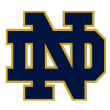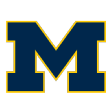The connections between the four teams set to play in the men's Frozen Four semifinals are undeniable, starting with Thursday night's first game between Ohio State and Minnesota-Duluth.
The Bulldogs, last year's national runner up, needed significant help to get into the NCAA tournament. The last domino to fall was actually a Notre Dame overtime victory over Ohio State in the Big Ten final. That allowed the Bulldogs to sneak into the last at-large spot, thanks to a RPI rating .0001 better than that of University of Minnesota.
Meanwhile, Ohio State head coach Steve Rohlik spent 10 seasons as an assistant coach under Scott Sandelin at UMD, leaving for an assistant job at Ohio State one year before UMD went on to win the school's first national championship (2011). Now UMD, the team that's only in because the Buckeyes lost their conference title game, stands between Rohlik and Ohio State playing for its own national championship. And don't think Ohio State forgot that the Bulldogs ended its season last year in the opening round of the NCAA tournament in overtime.
The second semifinal will feature a pair of teams that have played each other four times already as conference foes, with the season series split 2-2. However, Michigan also may not have gotten here were it not for Notre Dame.
Michigan coach Mel Pearson believes his team's season turned a corner after being swept by Notre Dame in a home-and-home series in early January. The Wolverines lost a pair of close 2-1 games, but showed signs of life amid an 8-10-2 record, including a 3-7-2 mark in Big Ten play at that point.
UM then went 14-4-1 the rest of the way, including a home-and-home sweep of Notre Dame in mid-February, surging into position to claim an at-large bid after looking dead in the water at the midpoint of the season. Wins over Northeastern and Boston University, in which Michigan's ability to defend proved crucial in shutting down two highly skilled teams, punched its ticket to the Frozen Four for a record-tying 25th time.
The Irish are back in the Frozen Four for the second straight year. They had steamrollered the competition over the first half of the season, winning their first 13 games in the conference. Notre Dame forced the Big Ten teams to get better, and as the season wore on, most of them did. The Irish followed up their conference win streak with a 4-6-1 record to close out Big Ten play, but still managed to clinch the conference's regular-season title in early February. They ramped it right back up for the playoffs, winning the Big Ten championship, as well as a pair of tight regional games, dispatching Michigan Tech in overtime before beating Providence 2-1 on a game-winning goal with just 27 seconds remaining in regulation.
Ohio State and Minnesota-Duluth face off at 6 p.m. ET on Thursday, while Notre Dame and Michigan meet later that evening at 9:30 p.m. ET. The winners play for the championship on Saturday at 7:30 p.m. ET. All three games will be aired on ESPN2. Click here for the full schedule, bracket and tournament recap.
While each team can be appreciative for the roles their opponents may have played on their road to the Frozen Four, they'll now have to get through each other to get what they came for. Here's a look at all four teams vying for the national title in St. Paul.

Ohio State Buckeyes
The Buckeyes are back in the Frozen Four for the first time since 1998 and only the second time in program history. They got here on the strength of a defensive game anchored by veteran goalie Sean Romeo, while top forwards Tanner Laczynski and Mason Jobst carried the load offensively. The Buckeyes also have the nation's top penalty kill, boasting an impressive 89.3 percent success rate with the disadvantage.
With only one freshman getting regular playing time, Ohio State is a veteran team that has been trending up in recent seasons, posting improved records and earning tournament berths in each of the past two seasons as Rohlik continues building his program.
"I think Ohio State is the best team we've played all season long," said Notre Dame head coach Jeff Jackson, whose Irish beat the Buckeyes in four of five meetings. "We got some breaks against them."
Notre Dame was the only team Ohio State regularly struggled against. It swept the season series against rival Michigan and ended up bouncing the Wolverines in overtime in the semifinal of the Big Ten tournament. Before the Buckeyes can get another crack at their conference foes, they've got a formidable opponent in Minnesota-Duluth. There's enough players on the Ohio State roster to remember the sting of last year's season-ending loss to the Bulldogs.
"We hadn't been [in the tournament] in a while as a program, going against one of the best teams in the country at the time," Rohlik recalled. "I thought [UMD] were definitely the better team. It was a good learning experience."
Now they'll look to put those lessons to good use on college hockey's biggest stage.
Key players
Tanner Laczynski, C/W, sophomore: The Philadelphia Flyers prospect leads Ohio State with 46 points in 40 games. He is also an excellent two-way player, which is why his stock as a prospect continues to rise. Laczynski is difficult to contain and has become a model for how the Buckeyes expect to play.
Mason Jobst, C, junior: A gifted skater, Jobst also has a solid skill set that has allowed him to score a team-best 21 goals. His ability to get to the good scoring areas and beat teams with speed in transition also has him on NHL radars as a potential free-agent option.
Sean Romeo, G, junior: After sitting last season out as a transfer from Maine, Romeo has been a rock between the pipes for the Buckeyes. He posted a .927 save percentage while making 36 appearances. Romeo was a major difference-maker in Ohio State's regional run, making 53 saves on 56 shots over the two games.
"He never wavers, never loses focus and doesn't take shortcuts," Rohlik said. "When you have a goalie like that, it gives your team confidence."

Minnesota-Duluth Bulldogs
After falling just short last year, this was supposed to be more of a transitional year for the Bulldogs. They lost several seniors and a few players earlier than expected to the pros, including starting goalie Hunter Miska, who was a major part of the team's success last season. Also gone are impact players such as Alex Iafallo, Neal Pionk and Dominic Toninato, all three of whom have seen time in the NHL already this season.
The Bulldogs have about 11 regulars from last year's team, with 10 freshman on the roster. On top of that, they're playing closer to home, providing another layer of excitement, pressure and perhaps distraction, especially for the 17 Minnesota natives on the roster. It's a challenge, but there's no doubt that they have talent throughout the lineup.
It's amazing that Minnesota Duluth got in at all, but the team appears to have been energized at the remarkable opportunity they've been given after getting into the tournament by the skin of their teeth, needing a lot of help after losing in the NCHC semifinals.
"When a couple of the other teams lost, the last-ditch scenario came up and the guys watched the end of the Notre Dame-Ohio State game. When Notre Dame won, they knew the consequences. It was pretty dramatic," said Scott Sandelin, head coach at UMD. "Maybe the way it happened gave our guys a sense of how hard it is and gave them a second life. They seized the opportunity with two hard-fought wins [over Minnesota State and Air Force in the regionals] to get the chance to go back to the Frozen Four."
Key players
Scott Perunovich, D, freshman: One of the big surprises of the season has been Perunovich's play as a freshman. He caught the eye of Team USA for the World Juniors with his early-season performance, but just kept producing throughout the year. He led the team in scoring from the blue line with 36 points, including 11 goals, and will likely earn a mid-round selection in the NHL draft after going unselected out of the USHL last year. Perunovich is a quality puck mover with higher-end hockey sense, making him a factor in all zones.
Riley Tufte, LW, sophomore: It took Tufte a while to adjust to the college game coming straight out of high school. However, the Dallas Stars first-rounder appears to be turning the corner a bit more this season. He led the Bulldogs with 16 goals after collecting 16 points all of last season. He still has a long road ahead as a prospect, but you have to like the upside of a 6-foot-6 forward who can skate, and you can expect him to make an impact this weekend.
Joey Anderson, RW, sophomore: He's only a sophomore, but Anderson plays such a mature, responsible game. He also has good speed and enough skill to be tough to defend. The New Jersey Devils prospect's numbers took a dip this year without some of the skilled veterans he played with last year, but he remains one of the Bulldogs' best players in terms of ability.

Notre Dame Fighting Irish
The Fighting Irish introduced themselves rather rudely to their new conference, posting 13 consecutive wins to open conference play. The Irish had previously been in Hockey East for four seasons after college hockey's realignment saw the dissolution of the CCHA. Hockey East challenged the Irish, but proved to be an ill fit geographically, leading Notre Dame to head to more familiar territory with former CCHA opponents Michigan, Michigan State and Ohio State in the Big Ten.
Winning both the regular-season and tournament titles in their first year in the conference has been nice, but there are a lot more reasons it has been a beneficial move.
"We found out in the second half how challenging the conference is and how much better it got," said Jackson, noting he isn't surprised to see three Big Ten teams in the Frozen Four. "For our program, it was an obvious move. It's helped our fan base and our team in terms of travel. We're playing against big-time programs every night. It's created more of a buzz in our building. It's going to be exciting to watch as it grows over the next several years."
Notre Dame's second half had more stumbles, but the recovery has been impressive in the postseason. The Irish have won each of their past four games by one goal. It certainly doesn't hurt to have the best goalie in the country stopping pucks for them.
Jackson, who just received the Spencer Penrose Award as the nation's top coach, always has a team that is going to be tough to play against. Led by a veteran D corps that has the ability to get the puck up ice and play a physical brand of hockey, the Irish excel based on their depth. All of their lines offer unique challenges, and if teams can manage to cut through their defensive structure, Cale Morris is there as the last line of defense. Every game against Notre Dame is going to be a battle.
"They don't beat themselves," Pearson said.
Key players
Cale Morris, G, sophomore: The front-runner for the Mike Richter Award as the nation's top goalie, Morris owns a .945 save percentage and 1.91 goals-against average. The undrafted free agent played less than 20 minutes last season as an understudy to Cal Petersen, who ended up signing with the Los Angeles Kings after his junior year. It has been one of the more dominant performances by a college goalie in recent memory.
"I think he's had a bigger impact on our team than any player has had [on his team] in the country," Jackson said.
Jake Evans, C/W, senior: These past two seasons have been eye-opening as Evans has come into his own as a player. With 84 points over that time, Evans has been an offensive catalyst for the Irish. He has good playmaking skills and isn't afraid to get his nose dirty to create chances. He has gone from borderline prospect selected in the seventh round to a player the Montreal Canadiens should be eager to sign.
Jordan Gross, D, senior: Gross provides both stability and production on the back end as Notre Dame's top blue liner. He had 38 points this year, but the two biggest came against Michigan Tech in the opening round, as he scored a pair of goals -- including the overtime game-winner -- to help the Irish avoid a scare. Expect him to play big minutes.

Michigan Wolverines
The turnaround job Mel Pearson did in his first season at Michigan has been especially impressive. In earlier viewings of Michigan, the team didn't seem to have much of an identity or strong enough structure. That was easy to understand with a new head coach coming in and trying to replace Red Berenson, who retired after 33 years behind Michigan's bench. Even though Pearson was a longtime assistant of Berenson's, he had spent the previous six seasons as the head coach at Michigan Tech. The players didn't have much of a frame of reference for him, and they were young.
"We're the third-youngest team in college hockey, and that youth showed a lot of nights," Pearson said. "Red and I have a lot of the same philosophies, but it took a while for our guys to figure out who this guy from the [upper peninsula] in Northern Michigan was."
Having had a veteran top line led by junior Cooper Marody throughout the season allowed the Wolverines to stay afloat when it looked like they were cooked. Once they started building more chemistry, getting better goaltending from Hayden Lavigne and getting their younger players better acclimated to the way they wanted to play, things took off.
It culminated in a pair of hard-fought wins in the regional. The Wolverines managed to hold the nation's top scoring line in check to beat Northeastern before sending Boston University's roster full of top-level NHL draft picks home. As impressive as they can be offensively, Michigan showed they can take care of their own end, too.
Key players
Quinn Hughes, D, freshman: One of the more entertaining players to watch in college hockey, Hughes is expected to be a top-10 pick in the 2018 NHL draft. Pearson expects his freshman blueliner to play somewhere between 25 and 30 minutes Thursday alongside Joseph Cecconi on Michigan's top pairing. Hughes has 29 points in in 36 games. His 0.81 points per game is the seventh highest for a defenseman 18 or younger in the NCAA since 1997-98. Over his past 20 games, Hughes has registered 19 points.
Cooper Marody, C, junior: An especially creative forward, Marody isn't going to blow by anyone with speed. He uses a higher-end hockey sense to exploit gaps and has the hands to beat defenders one-on-one. Perhaps that's why the Edmonton Oilers traded for his rights in mid-March. The former Flyers draft pick has been excellent for the Wolverines all season with 50 points in 39 games, ranking sixth in the country in scoring.
"He's very creative not only with hockey, but off the ice," Pearson said of his leading scorer. "You can see that in his game. He's a fantastic young man, very cerebral. He has some of that 'it' factor. Quinn Hughes has the same wow factor. We're in the entertainment business, and those guys entertain."
Tony Calderone, RW, senior: Another veteran helping carry this team through its early struggles, Calderone has been a goal-scoring machine this year. The Michigan captain has 24 goals, showing off a nasty release. He's garnering some interest as an undrafted UFA amid his senior breakout.
